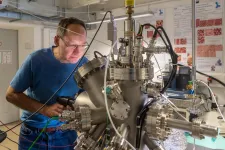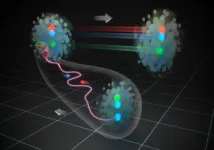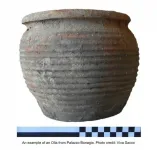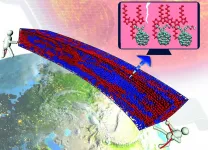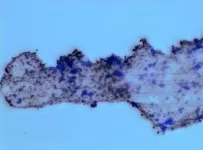(Press-News.org) An international research team led by members from the Technical University of Munich, the Deutsches Museum, Munich, and the Swedish Linköping University has developed a method to manufacture two-dimensional polymers with the thickness of a single molecule. The polymers are formed on a surface by the action of light. The discovery paves the way to new ultrathin and functional materials.
The quest for new two-dimensional materials has rapidly intensified after the discovery of graphene - a supermaterial whose excellent properties include high conductivity and strength, making it incredibly versatile.
Two main approaches are used to create ultrathin materials. In the first, a continuous layer of molecules or atoms is "peeled off" from the bulk of the material. Graphene is an example of such a material.
The other approach, in contrast, involves the construction of the material molecule-by-molecule by producing bonds between the molecules in various ways. The problem is that the materials are often small, fragile and contain many defects. This limits the potential areas of application.
Self organization and photopolymerisation produce new 2D-material
An international research team with members from the Technical University of Munich, the Deutsches Museum and Linköping University, among others, has now developed a new method to manufacture two-dimensional polymers. The discovery makes it possible to develop new ultrathin functional materials with highly defined and regular crystalline structures.
The manufacture, or polymerisation, of the material takes place in two steps. The researchers use a molecule known as "fantrip". "Fantrip" is a contraction of "fluorinated anthracene triptycene". This molecule is a merger of two different hydrocarbons - anthracene and triptycene. The specific properties of fantrip cause the molecules to spontaneously arrange themselves into a pattern when they are placed onto a graphite surface covered with an alkane. This process is known as "self-organization".
The next step is the photopolymerisation itself, when the pattern is to be fixed with the aid of light. The molecules are illuminated by a violet laser that excites the electrons in the outermost electron shell. This causes strong and durable covalent bonds to form between the molecules.
The result is a porous two-dimensional polymer, half a nanometre thick, consisting of several hundred thousand molecules identically linked, in other words, a material with nearly perfect order, right down to the atomic level.
Simulations confirm the assigned structures
Since the photopolymerisation is carried out on a surface of solid graphite, it is possible to follow the process on the molecular scale using scanning tunnelling microscopy. This shows the newly formed bonds in a persistent network. In order to confirm the structure assignment, the research group led by Jonas Björk has simulated the appearance of the molecular networks under the microscope at different stages of the reaction.
Jonas Björk is assistant professor in the Materials Design Division at the Department of Physics, Chemistry and Biology at Linköping University. He has used high-performance computing resources at the National Supercomputer Centre in Linköping to validate the experiments and understand the key factors that make the method successful.
"We see that the simulations agree well with reality down to the tiniest detail, and we can also understand why our specific system gives such useful results. The next step of the research will be to see whether the method can be used to link other molecules for new two-dimensional and functional materials. By improving the method, we will also be able to control and tailor the type of ultrathin materials we aim to manufacture", says Jonas Björk.
Fixing self-organized molecules with light
"Creating covalent bonds between molecules requires a lot of energy. The most common way of supplying energy is to raise the temperature, but this also causes the molecules to start moving. So it won't work with self-organized molecules, since the pattern would blurr. Using light to create covalent bonds preserves the pattern and fixes it precisely as we want it", says Markus Lackinger, research group leader at the Deutsches Museum and Technical University of Munich.
The polymerisation takes place in a vacuum, which ensures that the material is not contaminated. However, the final two-dimensional polymer film is also stable under atmospheric conditions, which is an advantage for future applications. Markus Lackinger believes that the material will find many conceivable applications.
"The most obvious application is to use the material as filter or membrane, but applications that we have no idea of at the moment in entirely different contexts may appear on the horizon, also by chance. This is why basic research is so exciting", says Markus Lackinger.
INFORMATION:
The research has been funded by the Deutsche Forschungsgemeinschaft (DFG) via grant LA 1842/9-1 and the Cluster of Excellence Nanosystems Initiative Munich (NIM) as well as the Swedish Research Council and the Swedish Government Strategic Research Area in Materials Science on Functional Materials at Linköping University. The calculations were carried out at the National Supercomputer Centre at Linköping University. Other partners in the project were the University of Nevada (Reno, USA), as well as Physical Electronics GmbH and neaspec GmbH (both Germany).
WASHINGTON -- In a new study, researchers demonstrate an automated, easy-to-operate quantum key distribution (QKD) system using the fiber network in the city of Padua, Italy. The field test represents an important step toward implementing this highly secure quantum communication technology using the type of communication networks already in place in many regions around the world.
QKD offers impenetrable encryption for data communication because it uses the quantum properties of light to generate secure random keys for encrypting and decrypting data.
"QKD can be useful in any situation where security is paramount because it offers unconditional security for the key exchange process," ...
Two gene variants found in African American women may explain why they are more likely to be diagnosed with triple negative breast cancer (TNBC) than white women of European ancestry, according to Weill Cornell Medicine and NewYork-Presbyterian investigators. The study findings may have implications for developing better risk assessment tools for TNBC in African American women and for understanding why they have poorer TNBC outcomes.
In a study, published April 29 in Scientific Reports, the investigators found that a version of the ANKLE1 gene that can be protective against TNBC is less likely to be found in African American women than white women of European ancestry. In addition, African American women with a mutation in the Duffy gene, which plays a role in inflammation, ...
Inside each proton or neutron there are three quarks bound by gluons. Until now, it has often been assumed that two of them form a "stable" pair known as a diquark. It seems, however, that it's the end of the road for the diquarks in physics. This is one of the conclusions of the new model of proton-proton or proton-nucleus collisions, which takes into account the interactions of gluons with the sea of virtual quarks and antiquarks.
In physics, the emergence of a new theoretical model often augurs badly for old concepts. This is also the case with the description of collisions of protons with protons or atomic nuclei, proposed by scientists from the Institute of Nuclear Physics of the Polish Academy of Sciences (IFJ PAN) ...
Organic residues on ceramic pottery are a valuable resource for understanding medieval cuisines of Islamic-ruled Sicily, according to a study published June 9, 2021 in the open-access journal PLOS ONE by Jasmine Lundy of the University of York, UK and colleagues.
During the 9th to 12th century AD, Sicily was under Islamic rule. This transition is known to have profoundly impacted the region, and the capital city of Palermo thrived as an economic and cultural center of the Mediterranean Islamic world. But little is known about how the lives of people in the region were impacted during this important time period.
In this study, researchers examined organic residues of plant and animal products on ceramic pottery to gain insights ...
Today, solar energy provides 2% of U.S. power. However, by 2050, renewables are predicted to be the most used energy source (surpassing petroleum and other liquids, natural gas, and coal) and solar will overtake wind as the leading source of renewable power. To reach that point, and to make solar power more affordable, solar technologies still require a number of breakthroughs. One is the ability to more efficiently transform photons of light from the Sun into useable energy.Organic photovoltaics max out at 15% to 20% efficiency -- substantial, but a limit on solar energy's potential. Lehigh University engineer Ganesh Balasubramanian, like many others, wondered if there were ways to improve the design of solar cells to make them more ...
GRAND RAPIDS, Mich. (JUNE 8, 2021) -- Chronic inflammation in the gut may propel processes in the body that give rise to Parkinson's disease, according to a study by scientists at Van Andel Institute and Roche.
The study, published in Free Neuropathology, is the latest in a growing list that links the gut and the immune system to Parkinson's. The researchers' findings in an experimental mouse model of gut inflammation track with several large-scale epidemiological studies that show an association between Parkinson's and inflammatory bowel diseases, such as ulcerative colitis and Crohn's disease.
Epidemiological evidence from other groups indicates the risk of developing Parkinson's fades in certain people whose ...
Small pieces of plastic are everywhere, stretching from urban environments to pristine wilderness. Left to their own devices, it can take hundreds of years for them to degrade completely. Catalysts activated by sunlight could speed up the process, but getting these compounds to interact with microplastics is difficult. In a proof-of-concept study, researchers reporting in ACS Applied Materials & Interfaces developed self-propelled microrobots that can swim, attach to plastics and break them down.
While plastic products are omnipresent indoors, plastic waste and broken bits now litter the outdoors, too. The smallest of these ...
TORONTO, June 9, 2021 - Researchers from York University and the University of British Columbia have found social media use to be one of the factors related to the spread of COVID-19 within dozens of countries during the early stages of the pandemic.
The researchers say this finding resembles other examples of social media misinformation ranging from the initial phase of vaccine rollout to the 2021 Capitol riot in the United States.
Countries with high social media use leading to off-line political action prior to the pandemic, as surveyed before the pandemic by V-Dem (a database from the University of Gothenburg), showed ...
Skoltech researchers and their colleagues from RAS Institute for Physics of Microstructures, Lobachevsky State University of Nizhny Novgorod, ITMO University, Lomonosov Moscow State University, and A.M. Prokhorov General Physics Institute have found a way to increase photoluminescence in silicon, the notoriously poor emitter and absorber of photons at the heart of all modern electronics. This discovery may pave the way to photonic integrated circuits, boosting their performance. The paper was published in the journal Laser and Photonics Reviews.
"Natural selection" in semiconductor technology ...
Vertebrate life began in the water, but around 340-360 million years ago, four-limbed creatures, or tetrapods, made the transition onto land. In the years that followed, some species adapted to terrestrial life, while others turned back to the water and readapted to an aquatic lifestyle.
A new study of these early amphibians, published in the journal PLOS ONE and led by Penn paleontologist Aja Carter, suggests that these environmental shifts left an impression--on the shape of the animals' spines.
"I'm interested in how the shapes of the vertebrae affect how animals move," she says. "Our findings suggest that, in at least one part of the vertebrae, the shape of the bones ...
